
JULIA LEE BARCLAY-MORTON – YOGA, WATER AND REWRITING AUTISM
I interviewed writer Julia Lee Barclay-Morton about her experience of autism. Julia began as an experimental dramatist in New York, moving to the UK to
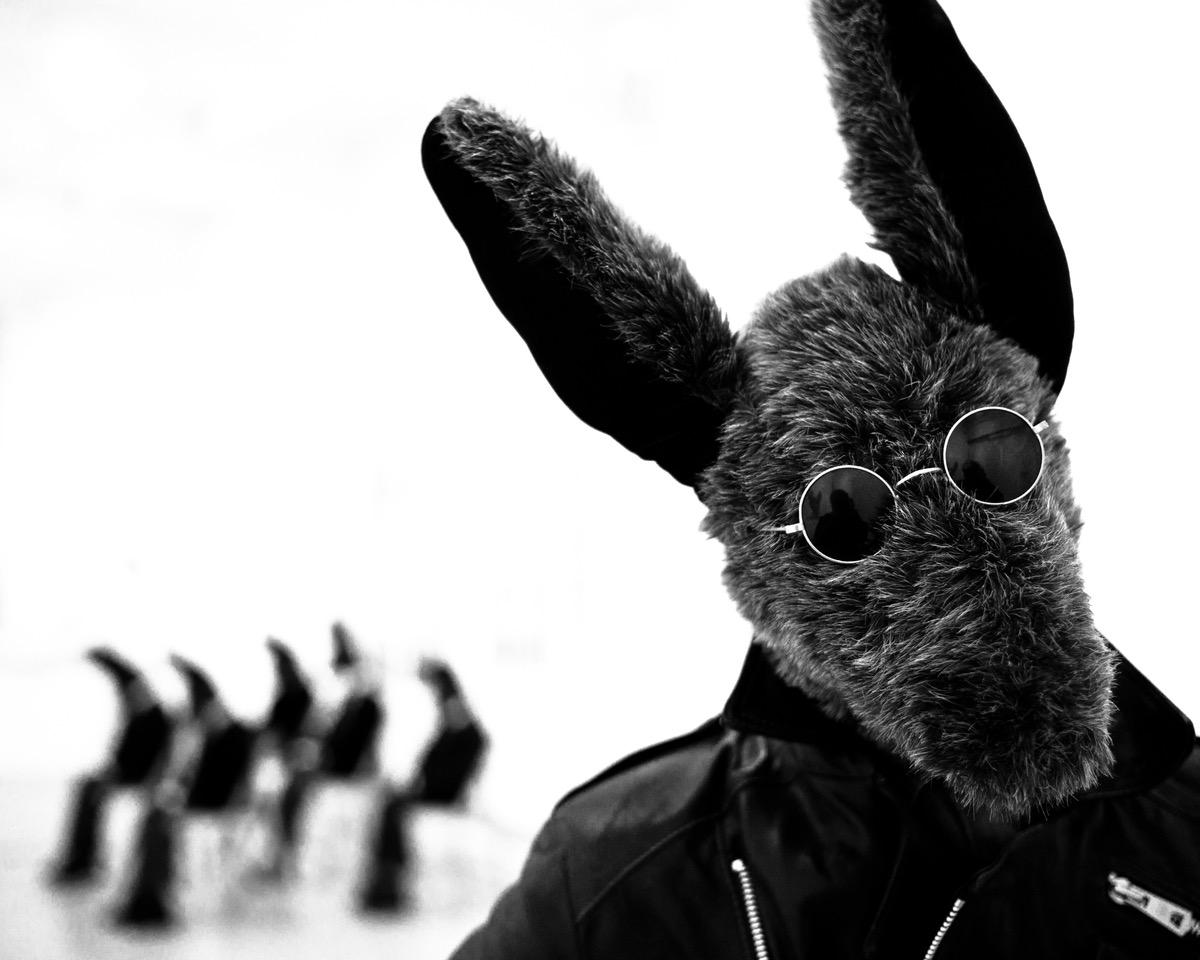
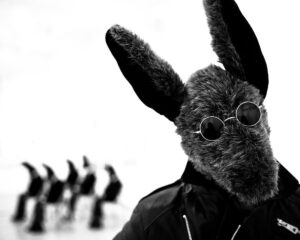
I interviewed artist Heather Tweed whose creative work embraces painstaking historical research, popular 19th Century entertainment, and dark & mythic dream-figures. Heather’s often teasing and evocative art has been shown in Venice, Bristol and at The Edinburgh Festival. Heather, who studied at Exeter, Leicester and City University London, is a multi-media artist and teacher practised at using paper maché, sculpted clay, language and sewn fabric.
Leslie: What was it about your childhood and education that gave you your continuing interest in art, sculpture, sewing and books?
Heather: My sister and I were very lucky. We grew up surrounded by books, and parents who valued the enjoyment of learning and also enjoyed making things. Those things ranged from model aircraft to artistic creations to a large wooden cabinet made by Dad to house his hi-fi system. We nicknamed it ‘the coffin’.
They taught me to read and I astonished relatives by reading newspaper headlines at the age of four! I still treasure the book Dad took me to chose as a prize for getting through the not untroubled process!
As for the sewing. Mum did some outsourced work at home, sewing blouses for a well known store. Chains of chiffon sleeves billowed onto the floor and I was allowed to help by neatly clipping the threads to separate the identical pieces. Yes, I was using very sharp scissors before school age and took care never to run with them!
We lived in a New Town not far from London and took very welcome trips to the major museums and art galleries. The British Museum was my favourite and I would make a bee line for the Egyptian Galleries.
Leslie: If I came across your installation ‘Anubis Other World Tour’ in a gallery, what would I see? Tell us the story of how your installation started and how it became what it is today.
Heather: I’ve always sculpted and specialised in sculptural ceramics at Art College, making large scale constructions. When I left I didn’t have access to a kiln and started experimenting with paper dipped in hot wax then hand-sewn onto bamboo pole structures. It was very satisfying and worked well with either large free-standing or wall pieces. I took a Post Graduate Certificate in Education course and hadn’t quite realised how much creative energy would go into the teaching over the next ten years or so. After a while I felt the urge to make my own artwork again and made some small paper mâché pieces for a group exhibition. I needed to go bigger! I made a life-size seated figure based loosely on my vision of Ancient Egyptian god Anubis from paper mâché and that had a really positive reception at another group exhibition. I really felt I needed to start creating and exhibiting again. As a child I’d had a recurrent nightmare where I was hiding in a house from a prowling be-suited wolf figure. One morning I woke up & started designing & cutting a pattern for a life-size figure based on my own proportions. I found some wonderful grey faux fur, described as ‘badger’ but perfect for a wolf/Anubis figure. My nightmare had become externalised and fused with my deep interest in Ancient Egypt. I planned a solo show and the installation grew to include a wise ‘Elder’ figure, a leopard and a classroom full of smaller schoolboy Anubis figures, all with their own personalities and clothed suitably. The schoolboys wore the ties of the school I taught at. My husband and I developed a series of videos where the figures walk the earth evaluating the world. The walk through Tate Modern, filmed ad hoc guerrilla-style, was exciting as we were allowed to freely roam, I thought we’d be stopped!
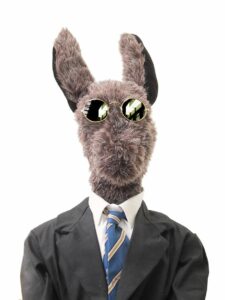
Instead of having eyes, I designed the figures to wear round sunglasses. This reflected how they’d evolved from my nightmare. A series of collaged canvasses developed reflecting places and landmarks important to me.
The installations have scared and delighted visitors in disused buildings, spookily lit in a network of caves, an old Crown Court building as well as more traditional gallery settings.
Leslie: Could you tell us about the various extraordinary venues for ‘Lost Not Found: Abscission’? What’s the full story behind the development of this project?
Heather: I’d been involved in an art vending machine project called Hayvend. I loved the idea of anyone being able to own a piece of artwork for a pocket-money price but with a gamble on what came out in the little box. It reminded me of an old Ali-Baba cave slot machine I loved as a child. You’d put a coin in, an elephant picked up a little box on its back then dropped it down an ornate treasure chest into my eager hands. What you got were only plastic trinkets, but I still have a little bracelet tucked away somewhere.
In 2009 an opportunity arose to take part in the Edinburgh Art Festival in August. I’d read Jung’s theories on Synchronicity ‘meaningful coincidences’ or events that appear to be related in some way but have no seeming causal connection and was aware of Geocaching where specific coordinates are used to find hidden goodies. My plan was to hide packaged artworks across sites special to me across Edinburgh with not a single clue to their whereabouts, just the serendipitous chance that anyone could discover a piece. I made small waxed-fur and bound Ushabti-type figures in my own style and packaged the artwork with instructions to email me with a photo of the piece. The finder could then either keep the artwork or leave it in another venue ready for another finder. An art treasure hunt with no clues! I had no idea what to expect. Lots of brilliant people got in touch with photos and some of the work moved quite a way. One to Australia. Nearly three quarters of the pieces were reported. Very satisfying. For the Edinburg Art Festival 2010, I selected a number of brilliant artists from an open call to carry out the same idea. It was equally successful. The project continued in a number of cities and Governors Island in New York. Sadly tightening security due to the terrorism threat put a halt to leaving strange packages in public places.
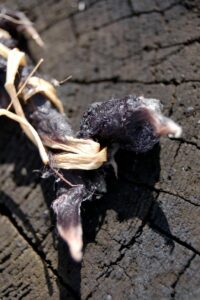
Leslie: You post ‘An Eclectic, deeply researched blog exploring Art and history with a leaning towards the 19th Century.’ Can you trace where the various aspects of this interest first began – and how they grew and developed?
Heather: I’ve always been inquisitive and hungry for knowledge across many disciplines with a slightly obsessive knack for unearthing facts from original sources. This also segues into your next question about my extraordinary Victorian woman…
Leslie: How and why have you used multi-media and cross-platform work in your latest project about a forgotten Victorian woman?
Heather: Around 10 years ago I read the amazing story of an extraordinary Victorian woman in an old copy of The Saturday Book. I left the book in the charity shop, the black and white images stuck with me and I searched for more information online. I found nothing. Kicking myself for not having bought the book I returned several days later and to my delight it was still there. I spent months researching and my resulting article was published by Public Domain Review. I’ve been deeply researching and writing about 19th century characters since then. I was invited to write a piece for Ripperologist magazine in 2018 and chose to research a little known true story about a tragic Music Hall murder. These characters drew me in and echoed back to some of my childhood interests. I wrote more articles and participated in Circus 250 with an exhibition celebrating the extraordinary Lulu Farini in a solo exhibition. The wifi power was sadly lacking in the gallery so not all of my ambitious plans came to fruition. It was an experiment and I’m working on future plans.
Leslie: What interests you most in history? What’s your personal way of researching people and topics?
Heather: Oh I so enjoy bringing lesser known 19th characters to life from original documentation and archives! I stumbled across my first Music Hall subject whilst researching someone else. As you can imagine I have many, many books about the 19th Century, including some rather specialised areas such as the history of London’s horse-drawn taxicabs, and the development of Circus and Music Hall. I have a subscription to The British Newspaper Archive and that allows me to search and read many 19th century Newspapers and periodicals for family announcements, advertisements and articles. Along with that I create a family tree. I have a subscription to an ancestry site which is really useful but you have to be careful especially with more common names that you are actually tracing the correct person. I triple check everything and always cross check with other sources. Finding a hand drawn tree in a vintage family bible untangled one particular conundrum that no end of online searching could. I search far and wide through specialist archives, museums, libraries and specialist holdings. Few things beat handling a tangible object or book and I’ve had very fruitful experiences at places such as The British Library, National Library of Scotland and National Portrait Gallery as well as smaller local archives. It can be quite exciting and moving to discover a missing jigsaw piece in a story.
I also make timelines, of the individual and their family and of various types of relevant events linked to their lives. All this is very time consuming and you really need to be on the ball with organisation to keep track of all the elements. I can be rather obsessive, rather a good thing as far as research goes. I plot the true story using novel structuring techniques and pull everything together in my own creative way making sure everything is factual but having fun bringing my characters back to life.
Leslie Can you tell us about the darkness, wry humour and spiritual sides of your artwork, please?
Heather: I’ll invite you along to my next exhibition to take in the atmosphere. Standing among the figures visitors often tell me they feel a palpable presence that can sooth or unsettle. I once had an exhibition in Brick Lane along from the Bodyworlds exhibition (the one where human corpses are stripped down to muscle and sinew then preserved in lifelike poses). I loved watching people either come in for respite, or look nearly as shocked as they were in Bodyworlds when they saw my installation.
Leslie: Can you give examples, please, of ‘gifts’ or random aspects that come into your work?
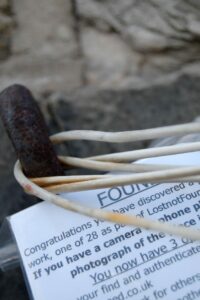
Heather: One rather big serendipitous coincidence is about the house where I live. When I moved down to South West England to take up a teaching post we rented. I’d met the teacher I was replacing, a pottery and art specialist who was divorcing and wanted to move away from the area. About 6 months after I’d started the job we fell in love with a place and decided to buy it. Around 6 miles from the school it had a wonderful atmosphere and a little overgrown courtyard area at the back. Clearing the brambles and weeds we discovered an A-Frame shop display board with a poster for a little antiques shop in town. I thought it would be useful for displaying art exhibitions in school. When I took it in a colleague asked where I’d found it as the advertised antiques shop belonged to the wife of my predecessor! You’ve guessed it! When we had a party our guests recognised it as the pottery teacher’s home. I’ve since discovered that before that in the 1970’s it was owned by a Dr who was on the local council and also ran a nearby pottery.
Leslie: How do people to react to your work? How has that changed your reaction to your own work and how you create the subsequent pieces?
Heather: Some viewers are rather startled by my work as I mentioned before. The strength of reaction in some people really surprised me. Some people ask if there’s anyone inside the sculptures. It can be a little alarming to see when there are piles of ‘bodies’ being tucked into the back of a van or car. Different people also see different creatures in the work. I’ve had them compared to rabbits and foxes, as well as kangaroos alongside wolf, dog and jackal. It intrigues me that there are so many interpretations. There must be a psychology to it. I’ve never explored that aspect. Because they stemmed from a nightmare they can be quite ambiguous although I know exactly what they are. I make my artwork for myself and never expected the sort of static-performative audience reaction they induce.
Leslie: Is art an immersive performance aimed at interesting and entertaining an audience?
Heather: I think art has many, many diverse manifestations. Some very quiet and personal, others more flamboyant and showy. In my own work I’ve certainly never set out to entertain, the concepts and processes of my art are very personal to me and any entertainment value has been an unexpected and interesting by-product. The artwork I’m personally most drawn to (immersed in) has a creative soul and intention that’s palpable when you stand before it. That could be a miniature portrait, a monumental sculpture, a deep, abstract conceptual piece or an impressive Tate Turbine Hall type experience. There are ways and ways of drawing viewers into the world of art, it doesn’t have to be all bells and whistles. In my teaching and workshop career I also learnt that honest passion and enthusiasm for artists you truly love can help communicate the most difficult concepts to even the most reluctant students and folk from all walks of life.
ABOUT LESLIE TATE’S BOOKS:

I interviewed writer Julia Lee Barclay-Morton about her experience of autism. Julia began as an experimental dramatist in New York, moving to the UK to

I interviewed Gillean McDougall from Glasgow, who edited the collaborative projects Honest Error (on Charles Rennie Mackintosh and his wife Margaret Macdonald) and Writing the

I interviewed French writer Delphine de Vigan, whose book, No et moi, won the prestigious Prix des libraires. Other books of hers have won a clutch

I interviewed Joanne Limburg whose poetry collection Feminismo was shortlisted for the Forward Prize for Best First Collection; another collection, Paraphernalia, was a Poetry Book Society Recommendation. Joanne

I interviewed Katherine Magnoli about The Adventures of KatGirl, her book about a wheelchair heroine, and Katherine’s journey from low self-esteem into authorial/radio success and
| Cookie | Duration | Description |
|---|---|---|
| cookielawinfo-checkbox-analytics | 11 months | This cookie is set by GDPR Cookie Consent plugin. The cookie is used to store the user consent for the cookies in the category "Analytics". |
| cookielawinfo-checkbox-functional | 11 months | The cookie is set by GDPR cookie consent to record the user consent for the cookies in the category "Functional". |
| cookielawinfo-checkbox-necessary | 11 months | This cookie is set by GDPR Cookie Consent plugin. The cookies is used to store the user consent for the cookies in the category "Necessary". |
| cookielawinfo-checkbox-others | 11 months | This cookie is set by GDPR Cookie Consent plugin. The cookie is used to store the user consent for the cookies in the category "Other. |
| cookielawinfo-checkbox-performance | 11 months | This cookie is set by GDPR Cookie Consent plugin. The cookie is used to store the user consent for the cookies in the category "Performance". |
| viewed_cookie_policy | 11 months | The cookie is set by the GDPR Cookie Consent plugin and is used to store whether or not user has consented to the use of cookies. It does not store any personal data. |
2 responses
A wonderful post, Leslie. I don’t know that much about art and I found this very interesting.
🙂 🙂 🙂